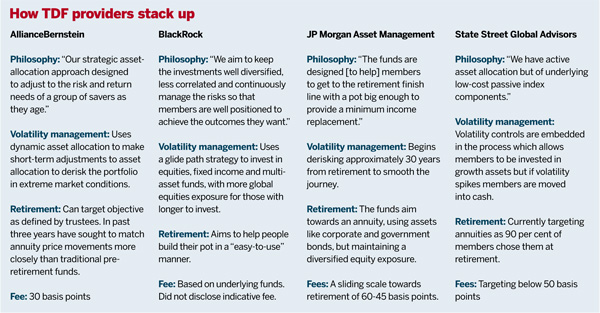State Street Global Advisors is the latest manager to detail its UK target date funds with an emphasis on volatility control, while consultants scrutinise the take-up and construction of these strategies.
TDFs are widely used in the US market but have not yet gained significant traction in the UK, save for their adoption by Nest.
State Street has this week launched its TDFs, which aim to offer a smooth, predictable journey for members. The funds will take an active asset allocation approach using underlying low-cost passive components.
We are constantly looking at a number of external influences to make sure these funds evolve
Nigel Aston
The manager has embedded volatility controls into the process, meaning members can be invested in growth assets, but if volatility strikes then investments are moved into cash. “Of course, it means in times of rapidly rising markets there will be a drag in performance,” said Nigel Aston, head of defined contribution.
Paul Herbert, senior investment consultant at Towers Watson, said initial interest prompted by Nest’s adoption of TDFs had subsided recently, despite employers reviewing their default strategies before or after auto-enrolment.
“As part of this process many fiduciaries have considered alternative solutions, including TDFs,” he said. “However, for a number of reasons this has not led to a significant move to TDFs.”
They can be a “blunt” tool for derisking members’ pots, he added, when they try to manage, in one fund, the retirement outcomes of everyone that retires in a five-year period, for example. State Street’s fund aims to compress the outcomes in this range to avoid big winners and losers and provide a good median return.
Suiting the ‘average’ member
The manager has also built in a governance structure based on legislation and research of member behaviour, including their views on risk and retirement objectives. The asset manager will also take into account macro-economic trends.
“We are constantly looking at a number of external influences to make sure these funds evolve,” said Aston. “What we are making sure with the dynamism we are building in through the governance process is that they stay fit for purpose.” The funds will have a comprehensive annual review but asset allocation is looked at weekly, he added.
But industry experts have criticised how TDFs construct their glide path strategies. Laith Khalaf, head of corporate research at investment provider Hargreaves Lansdown, said the glide path was based on “a whole feast of averages” such as historical average asset returns, asset correlations, pension fund sizes and contributions.
“You are trying to do something which we all have to do, which is accommodate the average member, but it is important not to lose sight of the fact that that is just a statistical construct, and it doesn’t apply to any one person in the workforce.”
While he welcomed a degree of active management for default fund members, he questioned the ability of TDF managers to call the market. “There are few people who are actually very good at consistently making those asset allocation calls.”
Nita Tinn, director at ITS, said: “One of the downsides is that they’re not commonplace within the UK yet, but there are a growing number of them being launched at the moment.” This means there is not that many to choose from and employers do not know that they are out there, she added.























